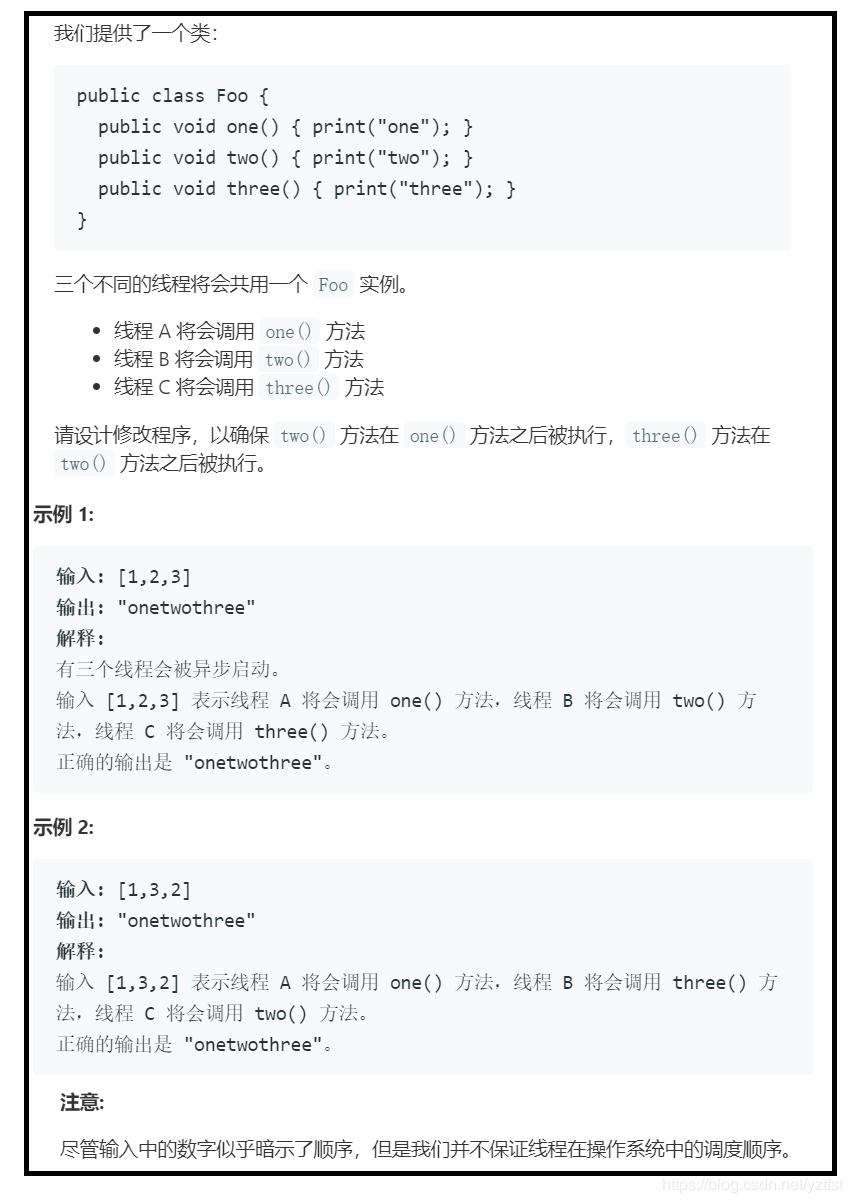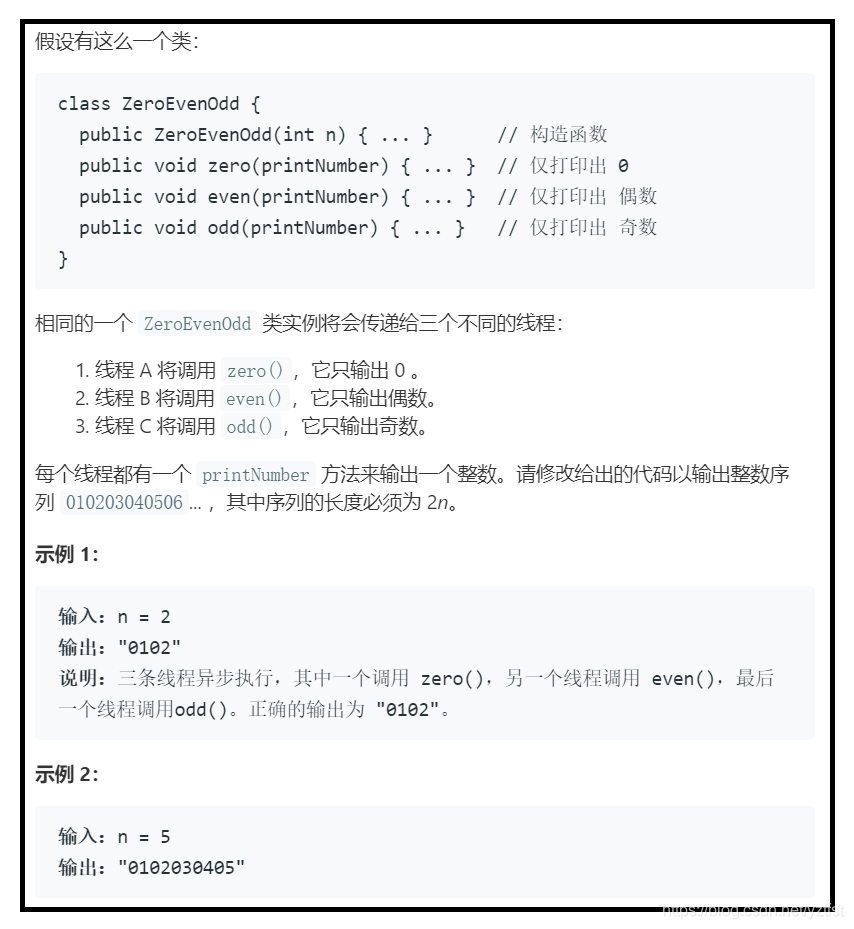按序打印

解法一:使用volatile
public class FooWithVolatile {
private volatile int count;
public FooWithVolatile() {
}
public void first(Runnable printFirst) throws InterruptedException {
// printFirst.run() outputs "first". Do not change or remove this line.
printFirst.run();
count++;
}
public void second(Runnable printSecond) throws InterruptedException {
// printSecond.run() outputs "second". Do not change or remove this line.
while(count != 1) { }
printSecond.run();
count++;
}
public void third(Runnable printThird) throws InterruptedException {
while(count != 2) { }
// printThird.run() outputs "third". Do not change or remove this line.
printThird.run();
}
}
类似的,我们也可以使用AtomicInteger,不过其实AtomicInteger底层也是使用了volatile字段,只不过在计算时会使用CAS解决原子性问题,但是这里的while循环对自增操作进行了阻塞,所以不会出现三个线程同时对count自增的情况,所以没必要使用AtomicInteger,更何况CAS操作里面的while循环也是很耗费资源的
解法二:使用CountDownLatch
public class FooWithCountDownLatch {
private CountDownLatch second = new CountDownLatch(1);
private CountDownLatch third = new CountDownLatch(1);
public FooWithCountDownLatch() {
}
public void first(Runnable printFirst) throws InterruptedException {
// printFirst.run() outputs "first". Do not change or remove this line.
printFirst.run();
second.countDown();
}
public void second(Runnable printSecond) throws InterruptedException {
second.await();
// printSecond.run() outputs "second". Do not change or remove this line.
printSecond.run();
third.countDown();
}
public void third(Runnable printThird) throws InterruptedException {
third.await();
// printThird.run() outputs "third". Do not change or remove this line.
printThird.run();
}
}
类似的,这里我们使用两个“门栓”栓住(阻塞)second方法和third方法执行run方法打印结果,当first方法执行完毕后,释放second的门栓让second方法打印结果,second方法执行完毕后,释放third的门栓让third方法打印结果
交替打印FooBar

class FooBarWithCountDownLatch {
private int n;
private CountDownLatch fooLatch = new CountDownLatch(0);
private CountDownLatch barLatch = new CountDownLatch(1);
public FooBarWithCountDownLatch(int n) {
this.n = n;
}
public void foo(Runnable printFoo) throws InterruptedException {
for (int i = 0; i < n; i++) {
fooLatch.await();
// printFoo.run() outputs "foo". Do not change or remove this line.
printFoo.run();
fooLatch = new CountDownLatch(1);
barLatch.countDown();
}
}
public void bar(Runnable printBar) throws InterruptedException {
for (int i = 0; i < n; i++) {
barLatch.await();
// printBar.run() outputs "bar". Do not change or remove this line.
printBar.run();
barLatch = new CountDownLatch(1);
fooLatch.countDown();
}
}
}
这里要注意,CountDownLatch和CyclicBarrier不一样,CountDownLatch是一次性的,countDown到0之后不会自己恢复成1,所以要每次new一个CountDownLatch对象。
打印零与奇偶数

public class ZeroEvenOdd {
private int n;
private CountDownLatch zero = new CountDownLatch(0);
private CountDownLatch even = new CountDownLatch(1);
private CountDownLatch odd = new CountDownLatch(1);
public ZeroEvenOdd(int n) {
this.n = n;
}
// printNumber.accept(x) outputs "x", where x is an integer.
public void zero(IntConsumer printNumber) throws InterruptedException {
for (int i = 0; i < n; i++) {
zero.await();
printNumber.accept(0);
zero = new CountDownLatch(1);
if(i % 2 == 0) {
odd.countDown();
} else {
even.countDown();
}
}
}
public void even(IntConsumer printNumber) throws InterruptedException {
for (int i = 2; i < n; i+=2) {
even.await();
printNumber.accept(i);
even = new CountDownLatch(1);
zero.countDown();
}
}
public void odd(IntConsumer printNumber) throws InterruptedException {
for (int i = 1; i < n; i+=2) {
odd.await();
printNumber.accept(i);
odd = new CountDownLatch(1);
zero.countDown();
}
}
}
这道题没什么好说的,做法也同样很多样,只要仔细点,都可以做对,但是我感觉都没直接用CoutDownLatch好。
H2O

public class H2O {
private Semaphore hSemaphore = new Semaphore(2);
private Semaphore oSemaphore = new Semaphore(0);
public H2O() {
}
public void hydrogen(Runnable releaseHydrogen) throws InterruptedException {
hSemaphore.acquire();
// releaseHydrogen.run() outputs "H". Do not change or remove this line.
releaseHydrogen.run();
oSemaphore.release();
}
public void oxygen(Runnable releaseOxygen) throws InterruptedException {
oSemaphore.acquire(2);
// releaseOxygen.run() outputs "H". Do not change or remove this line.
releaseOxygen.run();
hSemaphore.release(2);
}
}
实在想不到Semaphore以外的做法,虽然看题解确实有,但是反而不怎么好